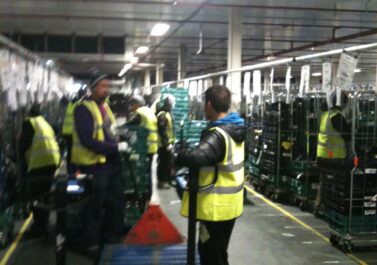Around Christmas time the news did it’s usual piece about big bad Amazon. This time, workers outside the Dumferline warehouse were sleeping in tents in the woods nearby to save themselves the travel and rent expenses. Over the last two years we have tried to spread a different kind of news: about the rebellious attitudes of Amazon workers in Germany and Poland, or the potential global character of workers’ resistance, looking at conditions of Amazon workers in India.
https://angryworkersworld.wordpress.com/2016/07/27/amazon-poland-over-2000-people-want-to-go-on-strike-but-restrictive-polish-labor-laws-prohibit-it/
https://angryworkersworld.wordpress.com/2015/12/20/welcome-to-the-jungle-working-and-struggling-in-amazon-warehouses/
https://angryworkersworld.wordpress.com/2015/11/11/amazon-in-india-the-e-commerce-jungle-and-workers-reality/
Apart from the usual philanthropic, victimising reports in the mainstream media, there has been other, less prominent news about workers’ discontent in the Christmas supply-chain. On November 28th 2016, workers at the Solihull branch of ‘Spectrum for Arcadia’, a logistics depot that’s part of the DHL Logistics Supply Chain and supplies major brands such as Topshop and Burton’s, walked out on strike as part of a pay dispute, asking for £1.25 more per hour. Workers at DS Smith, Saica and Smurfit Kappa also threatened strike action over pay in November. These workers make cardboard boxes for, amongst others, Amazon and Domino’s Pizza.
We still think it would be great to have an international newsletter for Amazon workers in the UK. We wrote down a basic proposal a while back, but use this opportunity to give it another little push.
https://angryworkersworld.wordpress.com/2015/11/06/open-letter-to-iww-comrades-regarding-amazon/
A good friend and former colleague of ours from west London worked at Amazon in Hemel Hempstead in the run up to Christmas 2016. Read his short report below. If you are interested in getting things rolling at your local Amazon warehouse, give us a nudge: angryworkersworld@gmail.com
——
“I worked at the Amazon warehouse in Hemel Hempstead (also known as Amazon fulfilment centre LTN2) this Christmas peak period, through the temp agency, Adecco.
The first day is called induction day or ‘day zero’. At the entrance, a member of Adecco ushered me into the conference room where another member of Adecco gave us a login card and locker number, then proceeded to the induction with the health and safety guidelines as well as the disciplinary procedures that were as follows:
– 0.5 points for late arrival, or if you leave earlier or come late back from breaks;
– 1 point for any absence; even if you notify in advance or explain the reason it doesn’t matter – you have the point anyway;
– 3 points for absence without prior notification;
– the accumulation of 6 points leads to termination of contract.
After the disciplinary issues we were told about shift times and pay rates. The day shift was from 08:00 till 18:30, 4 days on 3 days off, but they force you to sign a paper stating that you agree to work an extra day per week and / or extra hour per day. This was called mandatory overtime. I have to say that they didn’t put a gun to my head, but I guess that if I had refused to sign the paper, I would have been shown the exit door. As it turned out, only the first two weeks I worked 4 days on 3 days off, while during the rest of the period I had to work an extra hour EVERY day plus a fifth day. This meant that the working day was from 07:00 till 18:30, working 57.5 hours a week. I had the feeling that 2 days off were not enough and my other colleagues felt similar.
The next issue was the pay rates. On the day that I went to the Adecco office to sign the contract I was told that the first 40 hours of the working week were paid £8.00 p/h plus £40 attendance bonus. The wage would increase to £9.60 ph for the 40th to the 50th weekly hour. Working 50 hours to the maximum of 60 hours a week was supposed to be paid at £10.60 p/h. Although I worked more than 40 hours per week I wasn’t paid the £40 bonus – the shift manager told me that this was due to having arrived late for work. I had arrived on time on the company parking lot, but due to the enormous traffic, I didn’t manage to clock in on time.
Finally we were told about the areas where we could be placed. These areas were: ‘Stowing’, which was putting items into picking slots in the picking shelf. ‘Picking’, which was following the scanner instructions and picking the items into a tote. ‘Packing’ meant putting the items into the box assigned by the computer system. I found out later on that there was also a ‘Shipping area’, but only permanent staff were employed there. They put the packed boxes onto pallets and load them onto trucks and vans.
I was allocated to the packing area. It is an area with workstations placed in lines around a conveyor belt, where each workstation consisted of a table with a label machine and a tape machine to built and seal the boxes. The job was basically to check the computer screen that then shows which products to pack and the type of box or cardboard envelope to pack them into. We can have “singles’, which meant a single item per box or cardboard or “multis”, which meant more than one item per box or cardboard envelope. I then had to build the box, take the items, put them in, take dunnage paper if required, seal the box, print the label and put it on the conveyor belt. On the first day I was told not to worry about performance but after three days Adecco staff were already pressuring me. They also gave you feedback, raising issues like you weren’t using enough dunnage paper, the label was placed wrong, mistakes, damage boxes etc…
After a week I was told to speed up because my performance or target was low. I asked the Adecco staff what the performance rate or target rate was to get the 100% they expected and they told me that for singles it was 102 items per hour and for multis 164 items per hour. Basically everyone I talked to told me that they were not matching the target – even permanent staff, so I don’t know how Amazon really measures these rates, but I can safely say that very few people met the target.
Another issue I would like to mention is the security and access to the warehouse. The security was, at some points, annoying. Mobile phones are not allowed inside the warehouse, as well as cigarettes, lighters, matches. So every time I had to go to the canteen I had to go through the security gates like at the airport, and if you have some metal with you, like belts, you have to remove that too, and go through a further check that includes taking off your shoes. Another issue I had was getting into the warehouse. I have a car and sometimes I had trouble accessing the car park, especially when I worked overtime and on leaving, I overlapped with night shift. It was not well organized and I had to suffer traffic jams inside the car park. Getting inside the warehouse every day and outside at the end of the shift also meant queuing because of the security checks and the accumulation of people in the turnpikes because we had to swipe our cards in order to get out. On the up side, the canteen was pretty decent (hot food, ping pong tables, computers) and the food was good and affordable.
Most people I talked to lived in London (different places like Hendon, Edgware, Camden, Wembley), as well as towns like Watford, Luton and Dunstable. I only meet one woman who lived in Hemel Hempstead itself and she told me that it took to her about half an hour on foot but that she usually got a lift with someone. If you didn’t have your own means of transport, you probably had no option but to take the bus provided by Amazon/temp agencies. They charged £7 a day (!) to take their bus, and I found out that the price was the same regardless of where you got on. I talked to some people that lived in Watford and Luton and they they had to pay the same as the ones who came from London (Wembley, Brent Cross was the pick-up point).
Apart from the transportation issue and the problems getting inside, once you actually got inside the warehouse the working environment was OK. It was a bit sour at some points because not many people talked to each other (at least in the packing area) and the radio isn’t on all the time (which for me is way better, because in my previous job at a distribution centre of a large supermarket chain, there was brain-drilling radio played all day long!).
We usually had the equipment to work properly, and in the packing area there were some people (called PG) who were in charge of keeping our boxes refilled, fixing problems with labels or the tape machine etc. This cut down on any time wasting from us doing the job we were supposed to do. I heard about a strike happening at the time by workers of cardboard boxes that supplied Amazon, but honestly, I have to say that we didn’t noticed any shortage of cardboard boxes…
Many of the people working at Amazon were temp workers. When I started I was never promised I would get a permanent job but on my first day, Adecco handed me a piece of paper asking whether I’d be interested in a permanent position. Some people hoped to stay on but I never heard about or was told about anyone actually being made permanent while I was there. I did talk to some permanent staff who had been kept on after last Christmas – one lady told me that the starting pay rate was £8.36 ph, increasing with time.
Regarding organization I could say it was OK, not the best I have seen but not the worst either. I thought it would be busy busy busy all of the time but on a few days Amazon shift managers were going around asking to people if they wanted to leave earlier without getting any disciplinary points. At some points, although rarely, we didn’t have much work in the packing area and I found out that sometimes there was a shortage of pickers – but was only 3 or 4 times in 7 weeks and between 30 to 60 minutes maximum, not big a issue at the end.
I will end by mentioning some differences between Amazon and my previous work as a picker in the W**canton warehouse for a large supermarket chain. I was employed by agencies in both places but unlike my previous job, at Amazon I didn’t get daily text messages telling me if I was needed or whether my shift was cancelled – often just two hours before my shift was supposed to start. And once inside the warehouse, the working environment at Amazon was safer than at the W**canton warehouse: there were no LLOPS or machinery around you, or heavy banana boxes to lift, or abrupt changes in temperature because you had to change from chill to ambient or produce areas. The managers on the ground floor were also more friendly and reasonable than my previous managers where I sometimes had the feeling of being treated like junk. At least at Amazon, the managers (and I talked to 4 or 5 of them every day) were more empathetic than the ones in W**canton. Apart from this, the pay rate is not so different between the two: Amazon permanent staff get £8.36 p/h and agency staff get £8 ph, at W**canton agency staff get the minimum wage (£7.20 p/h) and permanent staff get £9.60 p/h, which is almost the London Living Wage.
This is my experience at Amazon. I hope you find it interesting.”



